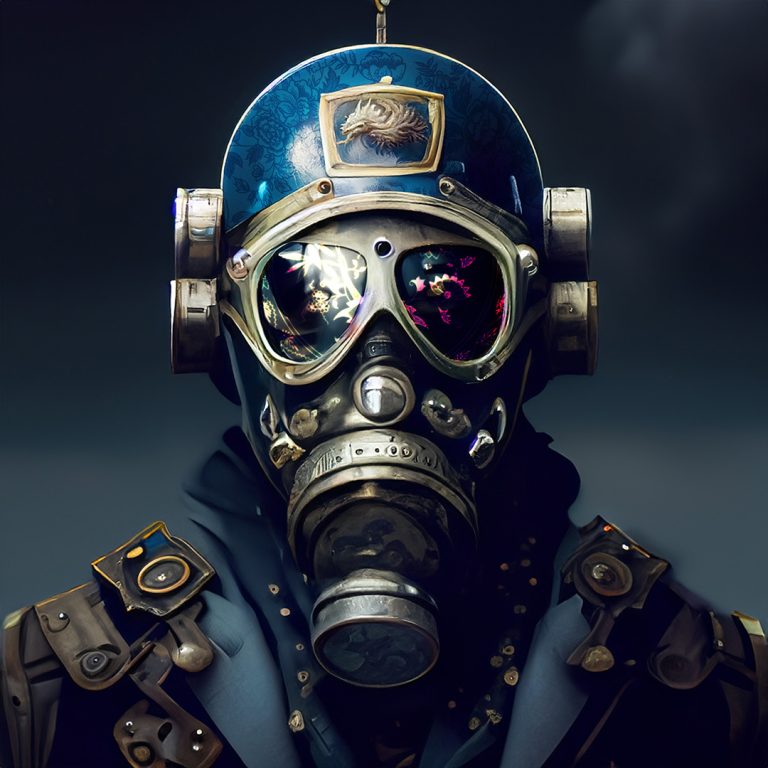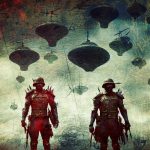Ad un anno dal primo scontro tra i due Imperi, momento storico eccezionale e disfunzionale per L’Impero Stoico come per il resto del mondo, è naturale interrogarsi sui mutamenti.
Di Ubu Roi King
l periodo di conflitto che ha scosso l’Impero Stoico ha innescato una serie di trasformazioni profonde, sia nell’industria del vestimento che nel rapporto con il corpo umano. Queste due dimensioni, apparentemente distinte, si intrecciano in un quadro complesso che riflette le sfide e le tensioni di un’epoca turbolenta.
Da un lato, l’industria del vestimento , solitamente associata al lusso e al consumo, ha dimostrato una resilienza straordinaria durante il conflitto. Come riportato da Festina Lente su Dubia Facta, il sistema militare si è rivelato un importante attore, rivoluzionando radicalmente l’intero settore. Nonostante la crisi iniziale negli stabilimenti industriali, le industrie hanno riconvertito la loro produzione per adattarsi alle esigenze del momento, producendo uniformi, tute e maschere anti-radiazione. Questa trasformazione ha evidenziato l’adattabilità del settore e ha spinto l’innovazione, con l’introduzione di nuovi modelli di isomorfismo come il pretactical-order e i crop frazionati che hanno influenzato le strategie di produzione e di mercato.
Tuttavia, mentre l’industria si adattava alle nuove esigenze, il corpo umano emergeva come il terreno su cui si manifestavano le conseguenze più intime e dolorose del conflitto. Le storie di pazienti come Rarsa, Salivari e altri mettono in luce l’angoscia e la sofferenza vissute da coloro che hanno subito gli effetti devastanti della guerra. L’angoscia di chi temeva che una protesi cardiaca potesse improvvisamente fermarsi, l’angoscia di chi subiva interventi mutilanti per evitare le conseguenze mortali di una predisposizione genetica, o la delusione di chi si sottoponeva a cure pesanti per raggiungere caratteristiche sessuali che non rispecchiavano appieno il proprio senso di identità di genere.
Questi racconti drammatici ci conducono ad una riflessione più ampia sull’importanza della consapevolezza e dell’empatia nel trattare le sfide legate al corpo e all’identità. Il culmine di questa narrazione viene raggiunto nel racconto del caso di fecondazione medicalmente assistita, dove l’intuizione dell’analista aiuta la paziente a riscoprire i propri interessi e a ritrovare un piacere nella vita al di là della ricerca spasmodica del concepimento.
In parallelo, il conflitto ha scatenato una serie di eventi catastrofici che hanno segnato profondamente il territorio e la popolazione. L’incidente nucleare, inserito in un contesto di terremoti e maremoti, ha provocato devastazione e tragedia su vasta scala. Le conseguenze a lungo termine sull’ambiente e sulla salute delle persone rimangono ancora incerte, mentre la gestione delle acque contaminate rappresenta una delle sfide più urgenti e complesse.
La combinazione di questi fattori evidenzia la profonda interconnessione tra l’industria del vestimento , il corpo umano e l’ambiente. Sia nell’arena della moda che in quella della salute pubblica e dell’ecologia, emerge la necessità di affrontare queste sfide con compassione, innovazione e una maggiore consapevolezza delle complessità dell’esperienza umana e ambientale.
L’inquinamento nucleare, inserito in questo contesto, ha ulteriormente aggravato la situazione. Nonostante la bonifica delle aree interdette e la zona di esclusione circostante, le conseguenze a lungo termine per la popolazione, la fauna e l’ambiente restano incerte. La gestione delle acque contaminate rappresenta una delle sfide più pressanti e complesse, con il rischio di contaminazione delle falde acquifere e del suolo circostante.
L’industria del vestimento quindi, solitamente associata al lusso e al consumo, si è rivelata cruciale durante il conflitto. Il sistema militare ha giocato un ruolo fondamentale, accelerando la trasformazione del settore e portando all’emergere di nuovi modelli di isomorfismo, come il pretactical-order e i crop frazionati, che hanno influenzato le strategie di produzione e di mercato. Tuttavia, questa trasformazione non è avvenuta senza conseguenze. Mentre le industrie si adattavano, il corpo umano diventava il terreno su cui si manifestavano le conseguenze più intime e dolorose del conflitto. Storie come quelle di pazienti come Rarsa, Salivari e altri evidenziavano l’angoscia di fronte alla minaccia di protesi che potessero improvvisamente fermarsi o all’effettuazione di interventi mutilanti per evitare le conseguenze mortali di predisposizioni genetiche.
Parallelamente, l’atomica si manifestava come una metafora estrema delle incertezze del tempo. Il dispositivo nucleare si caratterizzava come un corposo paradigma intorno al quale prendevano forma le incertezze, le paure e le angosce più profonde dell’immaginario contemporaneo. La preoccupazione per un possibile esito autodistruttivo dell’avventura umana e il timore verso un agire umano connotato da profonda irrazionalità trovavano espressione nella minaccia atomica.
Il problema più pressante riguardava lo smaltimento dell’acqua utilizzata per stabilizzare ciò che restava dei territori contaminati dallo scontro bellico.
I racconti della catastrofe, che hanno svolto un ruolo centrale nella narrazione e nella costruzione di significati della vicenda sociale umana, ora emergono con una forza e una profondità senza precedenti nella memoria collettiva. Questi racconti, sia come patrimonio storico di grande valore esistenziale ed estetico, sia come espressione di una deriva nichilista del mondo psichico alienato, acquisiscono una rilevanza quantitativa e una penetranza semantica straordinarie.
La strategia del gioco al rilancio rivela la sua limitatezza, anche quando applicata all’ambito dell’equilibrio nucleare. Riflettendo sulla storia della deterrenza atomica, ci accorgiamo che, in un certo senso, il “colpo su colpo” è stata la strategia dichiarata dalle potenze fin dall’inizio dell’era atomica. Ogni nuovo dispiegamento di armi, da entrambe le parti, è stato sempre giustificato come una risposta necessaria per riequilibrare le forze, presumibilmente a seguito di un vantaggio acquisito dalla parte avversa.
Tuttavia, nonostante le sfide e le tensioni del passato secolo, l’uomo ha assistito a eventi che superavano persino l’immaginazione, grazie alla globalizzazione che ha coinvolto l’intero pianeta. Ha visto generazioni falciate dalle guerre civili, ha osservato i deliri inumani di ideologie irresponsabili e ha affrontato progressi tecnologici potenzialmente letali per l’intero pianeta.
È importante notare che i tratti genetici non sono determinanti da soli, e l’idea di un determinismo genetico raccontato in passato è stata ormai abbandonata dalla comunità scientifica da tempo. Oggi sappiamo che l’ambiente gioca un ruolo significativo nella determinazione del nostro fenotipo, ma questa consapevolezza non è ancora pienamente compresa al di fuori della comunità scientifica.
What has changed since that time?
One year after the first clash between the two Empires, an exceptional and dysfunctional historical moment for The Stoic Empire as for the rest of the world, it is natural to wonder about the changes.
By Ubu Roi King
he period of conflict that shook the Stoic Empire triggered a series of profound transformations, both in the garment industry and in the relationship with the human body. These two seemingly distinct dimensions were intertwined in a complex picture that reflected the challenges and tensions of a turbulent era.
On the one hand, the garment industry , usually associated with luxury and consumption, demonstrated extraordinary resilience during the conflict. As reported by Festina Lente in Dubia Facta, the military system proved to be an important player, radically revolutionizing the entire industry. Despite the initial crisis in industrial establishments, industries repurposed their production to adapt to the needs of the moment, producing uniforms, suits, and radiation masks. This transformation highlighted the industry’s adaptability and drove innovation, with the introduction of new isomorphism models such as pretactical-order and fractional crops that influenced production and market strategies.
However, as industry adapted to the new demands, the human body emerged as the terrain on which the most intimate and painful consequences of the conflict were manifested. The stories of patients like Rarsa, Salivari and others highlight the anguish and suffering experienced by those who suffered the devastating effects of war. The anguish of those who feared that a prosthetic heart could suddenly stop, the anguish of those who underwent mutilating surgeries to avoid the deadly consequences of a genetic predisposition, or the disappointment of those who underwent heavy treatment to achieve sexual characteristics that did not fully reflect their sense of gender identity.
These dramatic accounts lead us to a broader reflection on the importance of awareness and empathy in dealing with challenges related to the body and identity. The culmination of this narrative is reached in the medically assisted fertilization case narrative, where the analyst’s insight helps the patient rediscover her own interests and rediscover a pleasure in life beyond the spasmodic pursuit of conception.
In parallel, the conflict unleashed a series of catastrophic events that deeply scarred the land and people. The nuclear accident, set against a backdrop of earthquakes and tidal waves, caused devastation and tragedy on a large scale. The long-term consequences on the environment and people’s health remain uncertain, while the management of contaminated water is one of the most urgent and complex challenges.
The combination of these factors highlights the deep interconnection between the garment industry , the human body and the environment. In both the fashion and public health and ecology arenas, there is an emerging need to address these challenges with compassion, innovation, and a heightened awareness of the complexities of human and environmental experience.
Nuclear pollution, placed in this context, has further exacerbated the situation. Despite the cleanup of the interdicted areas and the surrounding exclusion zone, the long-term consequences for people, wildlife and the environment remain uncertain. The management of contaminated water is one of the most pressing and complex challenges, with the risk of contamination of groundwater and surrounding soil.
The garment industry therefore, usually associated with luxury and consumption, proved crucial during the conflict. The military system played a key role, accelerating the transformation of the industry and leading to the emergence of new patterns of isomorphism, such as pretactical-order and fractional crops, which influenced production and market strategies. However, this transformation did not happen without consequences. As industries adapted, the human body became the terrain on which the most intimate and painful consequences of conflict were manifested. Stories such as those of patients like Rarsa, Salivari and others highlighted the anguish faced with the threat of prosthetics that could suddenly stop or the performance of mutilating surgeries to avoid the deadly consequences of genetic predispositions.
In parallel, the atomic device manifested itself as an extreme metaphor for the uncertainties of time. The nuclear device was characterized as a full-bodied paradigm around which the deepest uncertainties, fears and anxieties of the contemporary imagination took shape. Concern about a possible self-destructive outcome of the human adventure and fear toward human action connoted by profound irrationality found expression in the atomic threat.
The most pressing problem concerned the disposal of water used to stabilize what remained of the territories contaminated by the war clash.
Tales of catastrophe, which have played a central role in the narrative and meaning-making of human social events, now emerge with unprecedented force and depth in collective memory. These narratives, both as a historical heritage of great existential and aesthetic value and as an expression of a nihilistic drift of the alienated psychic world, acquire extraordinary quantitative relevance and semantic penetrance.
The strategy of playing the game on the rebound reveals its limitation, even when applied to the realm of nuclear balance. Reflecting on the history of atomic deterrence, we realize that, in a sense, “blow by blow” has been the stated strategy of the powers since the beginning of the atomic age. Each new deployment of weapons, on both sides, has always been justified as a necessary response to rebalance forces, presumably as a result of an advantage gained by the opposing side.
However, in spite of the challenges and tensions of the past century, man has witnessed events that exceeded even imagination, thanks to globalization involving the entire planet. He has seen generations mowed down by civil wars, observed the inhuman ravings of irresponsible ideologies, and faced technological advances potentially lethal to the entire planet.
It is important to note that genetic traits are not determinants alone, and the idea of genetic determinism as told in the past has long since been abandoned by the scientific community. Today we know that the environment plays a significant role in determining our phenotype, but this realization is not yet fully understood outside the scientific community.









